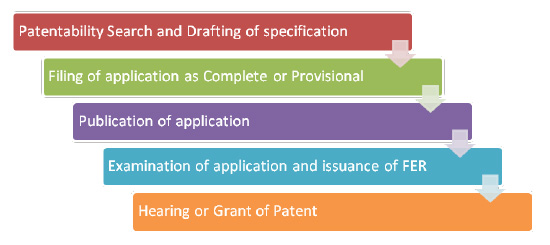 “Inventors do not invent for financial gain, they invent simply because they love to invent”. Isn’t it true? With this in mind, we shall move onto defining what patent is. A patent is basically a right or title given to inventors by the government for a certain period of time that precludes others from making, using or selling the invention during that period. This right comes with the onus of disclosure of the invention by the inventor to the public/government. Therefore, it can be said that a patent serves the purpose of not only protecting inventors but also motivating them to keep inventing.
“Inventors do not invent for financial gain, they invent simply because they love to invent”. Isn’t it true? With this in mind, we shall move onto defining what patent is. A patent is basically a right or title given to inventors by the government for a certain period of time that precludes others from making, using or selling the invention during that period. This right comes with the onus of disclosure of the invention by the inventor to the public/government. Therefore, it can be said that a patent serves the purpose of not only protecting inventors but also motivating them to keep inventing.
The first invention to be granted the intellectual property (IP) protection in India was titled “An Efficient Punkah Pulling Machine” in 1856. Needless to say, the number of patent filings and the Indian Patent office administration have transformed over the years to keep up with the IP boom.
The patent filing process in India is not very different from that of other jurisdictions and can be outlined as under.
1) Pre-filing (Checking for patentability and drafting)
It can be said without a doubt that the patent process starts with an idea which is conceptualized and then brought into existence after extensive research and development. Before a patent is filed, it is important to gauge whether the invention is novel, inventive/non-obvious and industrially applicable. In order to determine the novelty and inventiveness of an invention, an in-depth patentability search is conducted. This search reveals the documents (patent and non-patent) already available in the public domain commonly referred to as prior art references that could be destroying the novelty. It aids in providing a comprehensive view of the existing technology in the related field and how the invention is different or similar to such technology. It is essential to ensure that appropriate key strings and features are selected so that optimum results are achieved. This can be carried out using freely available databases by way of Google searches, patent office site searches or searches on paid databases like Scifinder, Ark Patent Intelligence, Orbit, Derwent Innovation etc. If a particular document is able to disclose each and every element of an invention, it is considered to be destroying the novelty. Furthermore, if one or more documents can be combined by a person skilled in the art i.e. person who has a working knowledge of the domain of invention to arrive at the solutions presented by the invention, then it makes it obvious and lacking of inventive step. Therefore, it is prudent to perform a search in order to save the applicant’s time and money before he goes ahead with the patent drafting and filing. However, there is more to obtaining a patent in India than novelty and inventiveness.
An Indian Applicant has to bear in mind that he/she not only fulfils the three aforementioned criteria, but also evade the list of non-patentable inventions mentioned in Section 3 of the Indian Patent Act, 1970. Special emphasis is placed on Sections 3(d), 3(e), 3(f), 3(i), 3(k) and 3(p). Section 3(d) of the Indian Patent Act states that “the mere discovery of a new form of a known substance which does not result in the enhancement of the known efficacy of that substance or the mere discovery of any new property or new use for a known substance or of the mere use of a known process, machine or apparatus unless such known process results in a new product or employs at least one new reactant. Explanation -For the purposes of this clause, salts, esters, ethers, polymorphs, metabolites, pure form, particle size, isomers, mixtures of isomers, complexes, combinations and other derivatives of known substance shall be considered to be the same substance, unless they differ significantly in properties with regard to efficacy”.This provision has been primarily incorporated to prevent ever-greening of patents which is prevalent in the pharmaceutical industry.
Once it is ascertained that a patent should be filed, drafting process can be initiated. A typical patent specification will have the following headings viz. field of the invention, background of the invention, object of the invention, summary of the invention, brief description of drawings, detailed description of the invention, examples, claims, abstract and drawings. The provisional specification entails the above headings sans the claims.A provisional specification may be filed when the invention is at a nascent stage of development and to secure a priority date.It is critical to secure the earliest possible priority date because it determines which documents will be considered as prior art against the application in question. A complete specification can subsequently be filed after 12 months which gives the applicant sufficient time to compile additional experimental data to strengthen the non-obviousness of the invention. However, if an applicant fails to file a complete specification within this period of 12 months, it will culminate with the application getting abandoned.
Since a patent application is a techno-legal document and provides legal protection of the invention, it has to be drafted cautiously so as to encompass the scope of the invention.
2) Filing process till grant
a. Filing
An application can be filed physically at either of the four Patent Offices viz. Delhi, Mumbai, Kolkata and Chennai or online (e-filing). The applicant also needs to decide what type of filing (ordinary, convention, PCT) and kind of entity/patent applicant he/she wishes to choose while filing. There are standard set of forms which need to be submitted along with the specification.However, the fees will depend on the type of patent applicant viz. natural person, start-up, small entity and others. Below are some of the important forms.
- Form 1 – Application for grant of patent
- Form 2– Provisional/ Complete specification
- Form 3–Details regarding corresponding applications filed out of India
- Form 5 – Declaration as to inventorship
- Form 18 – Request for examination
- Form 26 – Power of Attorney
b. Publication of application
The application is not disclosed to the public/published in the Official Gazette till the 18th month from the priority date or filing date whichever is earlier. The Patent Office also allows for early publication of the application (within one month) if a request via Form 9 is submitted. However, there are certain circumstances in which the publication may not be published even after this time period. This occurs in case the application is withdrawn 3 months prior to the 18 month period, application is abandoned (failure to file complete specification within 12 months from date of filing provisional specification) or if a secrecy direction is imposed as in case of defense related inventions.
c. Examination of application
Every application is examined formally and substantively, if not withdrawn or abandoned. However, this does not commence automatically, but is initiated when a request for examination (RFE)in Form 18 is filed. The applicant may file the RFE at the time of filing the application or within a period of 48 months from the priority date or date of filing the application whichever is earlier. The examination of an application can also be expedited, if a request for the same is made by a start-up or in cases where India is elected as the International Searching Authority or International Preliminary Examining Authority in the corresponding PCT application. An FER will usually have substantive objections related to novelty, inventiveness, non-patentability, scope, clarity, unity of invention, definitiveness and formal objections relating to updated form 3 details, POA with accurate details and stamp duty, complete forms with all required details, application to the National Biodiversity Authority if biological material from India is used in the invention (if biological material is sourced from outside India, then source and geographical origin needs to be mentioned), submission of the specification in appropriate format. In the past, section 4 (restricts the patenting of inventions relating to atomic energy)objections have also been raised with respect to the use of Gd, Hf, Zr in inventions since it falls within the scope of section 20(1) of the Indian Atomic Energy Act, 1962. In such cases, submissions can be made showing that the invention does not fall within the scope of the aforementioned Act.The objections are not limited to those specified above but may vary from case to case.
A response to FER should ideally be submitted within a period of 6 months. Nevertheless, the Indian Patent Office permits an extension of up to 3 months (excluding the statutory 6 month period), when a request along with requisite fee is made to the office within the statutory 6 month period. An applicant can expect grant of patent based on response filed to FER, if the Controller is satisfied that all the objections have been successfully responded to. In the alternative of pending objections, a Subsequent Examination Report (rarely) or a Hearing Notice maybe issued. Written submissions and relevant documents need to be submitted within fifteen days from the date of hearing.In cases where minor amendments need to be made after a response to FER has been filed, the Controller may even personally call the applicant/ his attorney to inform him/ her of the same.
3) Post-grant
A patent is finally granted if all the objections raised by the Controller have been sufficiently addressed by the applicant. Since there is no system of notice of grant in India, divisional application or voluntary amendments should be filed in advance during the prosecution stage. After the patent is granted, not only is it necessary to keep paying the renewal fees (applicable from the third year onwards), but it should also be monitored for post-grant opposition.The term of a patent in India is 20 years from the priority date or filing date, whichever is earlier. After the patent is granted, the onus on the applicant is to ensure that the invention is worked in India. This information pertaining to the working of an invention is available from Form 27 submitted every year by the applicant. If an applicant is not able to work an invention due to lack of funds or other resources, he may consider pursuing options like assignment or licensing.
Below is a simplified flow chart of the process for patent filing.

Article by Rebecca Mathai



